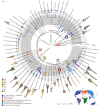Miocene fossils from the southeastern Pacific shed light on the last radiation of marine crocodylians
- PMID: 35538785
- PMCID: PMC9091840
- DOI: 10.1098/rspb.2022.0380
Miocene fossils from the southeastern Pacific shed light on the last radiation of marine crocodylians
Abstract
The evolution of crocodylians as sea dwellers remains obscure because living representatives are basically freshwater inhabitants and fossil evidence lacks crucial aspects about crocodylian occupation of marine ecosystems. New fossils from marine deposits of Peru reveal that crocodylians were habitual coastal residents of the southeastern Pacific (SEP) for approximately 14 million years within the Miocene (ca 19 to 5 Ma), an epoch including the highest global peak of marine crocodylian diversity. The assemblage of the SEP comprised two long and slender-snouted (longirostrine) taxa of the Gavialidae: the giant Piscogavialis and a new early diverging species, Sacacosuchus cordovai. Although living gavialids (Gavialis and Tomistoma) are freshwater forms, this remarkable fossil record and a suite of evolutionary morphological analyses reveal that the whole evolution of marine crocodylians pertained to the gavialids and their stem relatives (Gavialoidea). This adaptive radiation produced two longirostrine ecomorphs with dissimilar trophic roles in seawaters and involved multiple transmarine dispersals to South America and most landmasses. Marine gavialoids were shallow sea dwellers, and their Cenozoic diversification was influenced by the availability of coastal habitats. Soon after the richness peak of the Miocene, gavialoid crocodylians disappeared from the sea, probably as part of the marine megafauna extinction of the Pliocene.
Keywords: Gavialoidea; biogeography; longirostrine ecomorphs; marine crocodylians; phylogenetics.
Conflict of interest statement
We declare we have no competing interests.
Figures





Similar articles
-
Exceptional fossils from Peru and an integrative phylogeny reconcile the evolutionary timing and mode of Gavialis and its kin.Biol Lett. 2025 Aug;21(8):20250238. doi: 10.1098/rsbl.2025.0238. Epub 2025 Aug 6. Biol Lett. 2025. PMID: 40767471
-
Neuroanatomy of the crocodylian Tomistoma dowsoni from the Miocene of North Africa provides insights into the evolutionary history of gavialoids.J Anat. 2023 Jul;243(1):1-22. doi: 10.1111/joa.13846. Epub 2023 Mar 16. J Anat. 2023. PMID: 36929596 Free PMC article.
-
A New 13 Million Year Old Gavialoid Crocodylian from Proto-Amazonian Mega-Wetlands Reveals Parallel Evolutionary Trends in Skull Shape Linked to Longirostry.PLoS One. 2016 Apr 20;11(4):e0152453. doi: 10.1371/journal.pone.0152453. eCollection 2016. PLoS One. 2016. PMID: 27097031 Free PMC article.
-
Vicariance and dispersal in southern hemisphere freshwater fish clades: a palaeontological perspective.Biol Rev Camb Philos Soc. 2019 Apr;94(2):662-699. doi: 10.1111/brv.12473. Epub 2018 Oct 19. Biol Rev Camb Philos Soc. 2019. PMID: 30338909 Review.
-
The ecological importance of crocodylians: towards evidence-based justification for their conservation.Biol Rev Camb Philos Soc. 2020 Aug;95(4):936-959. doi: 10.1111/brv.12594. Epub 2020 Mar 10. Biol Rev Camb Philos Soc. 2020. PMID: 32154985 Review.
Cited by
-
Endocranial anatomy and phylogenetic position of the crocodylian Eosuchus lerichei from the late Paleocene of northwestern Europe and potential adaptations for transoceanic dispersal in gavialoids.Anat Rec (Hoboken). 2025 Feb;308(2):636-670. doi: 10.1002/ar.25569. Epub 2024 Sep 3. Anat Rec (Hoboken). 2025. PMID: 39228104 Free PMC article.
-
The temperate marine Peruvian Province: How history accounts for its unusual biota.Ecol Evol. 2024 Jul 21;14(7):e70048. doi: 10.1002/ece3.70048. eCollection 2024 Jul. Ecol Evol. 2024. PMID: 39041018 Free PMC article. Review.
-
The effects of cryptic diversity on diversification dynamics analyses in Crocodylia.Proc Biol Sci. 2025 Mar;292(2043):20250091. doi: 10.1098/rspb.2025.0091. Epub 2025 Mar 19. Proc Biol Sci. 2025. PMID: 40101764
-
Evaluation of the endocranial anatomy of the early Paleogene north African gavialoid crocodylian Argochampsa krebsi and evolutionary implications for adaptation to salinity tolerance in marine crocodyliforms.J Anat. 2025 Jun;246(6):974-986. doi: 10.1111/joa.14213. Epub 2025 Jan 15. J Anat. 2025. PMID: 39814549 Free PMC article.
References
-
- Hua S, De Buffrenil V. 1996. Bone histology as a clue in the interpretation of functional adaptations in the Thalattosuchia (Reptilia, Crocodylia). J. Vertebr. Paleontol. 16, 703-717. (10.1080/02724634.1996.10011359) - DOI
-
- Herrera Y, Fernández MS, Gasparini Z. 2013. The snout of Cricosaurus araucanensis: a case study in novel anatomy of the nasal region of metriorhynchids. Lethaia 3, 331-340. (10.1111/let.12011) - DOI
-
- Mazzotti FJ, Dunson WA. 1989. Osmoregulation in crocodilians. Am. Zool. 29, 903-920. (10.1093/icb/29.3.903) - DOI

